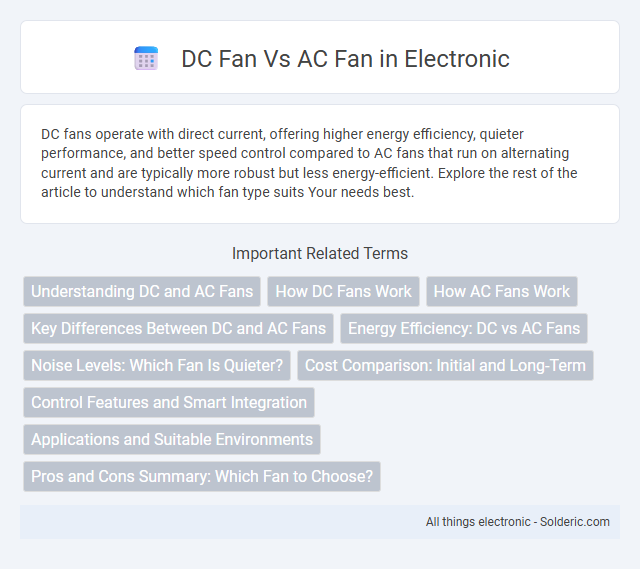DC fans operate with direct current, offering higher energy efficiency, quieter performance, and better speed control compared to AC fans that run on alternating current and are typically more robust but less energy-efficient. Explore the rest of the article to understand which fan type suits Your needs best.
Comparison Table
| Feature | DC Fan | AC Fan |
|---|---|---|
| Power Source | Direct Current (DC) | Alternating Current (AC) |
| Energy Efficiency | High efficiency, lower power consumption | Lower efficiency, higher power consumption |
| Speed Control | Precise and wide range speed control | Limited speed control, usually fixed speeds |
| Noise Level | Quiet operation | Generally noisier |
| Lifespan | Longer lifespan due to fewer moving parts | Shorter lifespan |
| Cost | Higher initial cost | Lower initial cost |
| Applications | Computers, electronics cooling, energy-efficient devices | Household fans, industrial ventilation |
Understanding DC and AC Fans
DC fans operate using direct current, providing higher energy efficiency, quieter operation, and precise speed control compared to AC fans, which run on alternating current and are generally simpler with less complex circuitry. Your choice between DC and AC fans impacts power consumption and noise levels, with DC fans favored in applications requiring variable speed and energy savings. Understanding the electrical principles behind each fan type helps optimize performance and suitability for different environments.
How DC Fans Work
DC fans operate using direct current electricity, powering a brushless motor that adjusts speed efficiently through electronic circuits. This precise control enables lower power consumption and reduced noise compared to traditional AC fans. Your cooling system benefits from DC fans' ability to provide consistent airflow with enhanced energy savings.
How AC Fans Work
AC fans operate by using alternating current to power an electric motor, which creates a rotating magnetic field that drives the fan blades. The speed of an AC fan is controlled by adjusting the voltage or frequency, often resulting in less precise speed control compared to DC fans. Understanding how AC fans work can help you choose the right fan type for applications requiring simple, reliable airflow with less emphasis on energy efficiency.
Key Differences Between DC and AC Fans
DC fans operate using direct current, offering higher energy efficiency and quieter performance compared to AC fans, which run on alternating current and typically consume more power. The precise speed control of DC fans allows for better customization in cooling applications, whereas AC fans often rely on fixed speeds or less efficient speed regulation methods. Your choice between DC and AC fans should consider power consumption, noise levels, and control flexibility to optimize performance for your specific cooling needs.
Energy Efficiency: DC vs AC Fans
DC fans offer superior energy efficiency compared to AC fans due to their ability to operate at variable speeds and lower power consumption. Your electricity bill can be reduced by up to 70% using a DC fan, as it converts current directly with minimal energy loss. AC fans, while generally less expensive, consume more power because they rely on alternating current and fixed-speed operation.
Noise Levels: Which Fan Is Quieter?
DC fans generally produce significantly lower noise levels compared to AC fans due to their efficient brushless motor design and variable speed control. Your environment will benefit from the quieter operation of DC fans, which reduce vibrations and motor hum, making them ideal for noise-sensitive spaces like bedrooms or offices. AC fans typically run at a constant speed with higher noise output, making them less suitable where quiet performance is crucial.
Cost Comparison: Initial and Long-Term
DC fans typically have a higher initial cost due to advanced motor technology and electronic controls, but they offer significant energy savings over time, reducing long-term operational expenses. AC fans generally feature a lower upfront price but consume more power, leading to increased electricity bills and maintenance costs in the long run. Investing in DC fans results in better cost efficiency through reduced energy consumption and longer lifespan.
Control Features and Smart Integration
DC fans offer precise speed control through PWM and voltage adjustments, enabling quieter operation and energy efficiency compared to AC fans. Advanced DC fan models support smart integration with home automation systems via protocols such as Zigbee, Z-Wave, and Wi-Fi, allowing remote monitoring and adaptive performance adjustments. AC fans typically provide limited control options such as variable resistors or triac dimmers, with fewer smart connectivity features, making DC fans more suitable for modern, connected environments.
Applications and Suitable Environments
DC fans excel in applications requiring precise speed control and energy efficiency, making them ideal for battery-powered devices, computers, and solar-powered systems. AC fans are better suited for high-power, industrial environments where constant speed and durability under continuous operation are essential. Your specific environment and power availability dictate the optimal fan choice, with DC fans favored in low-voltage or portable setups and AC fans preferred for stable, high-voltage installations.
Pros and Cons Summary: Which Fan to Choose?
DC fans offer higher energy efficiency, quieter operation, and better speed control compared to AC fans, making them ideal for environments requiring precise airflow and noise reduction. AC fans are generally more durable, cost-effective, and easier to maintain, suited for applications where affordability and robust performance are priorities. Choosing between DC and AC fans depends on balancing energy savings and noise levels against initial cost and maintenance needs.
DC fan vs AC fan Infographic

 solderic.com
solderic.com